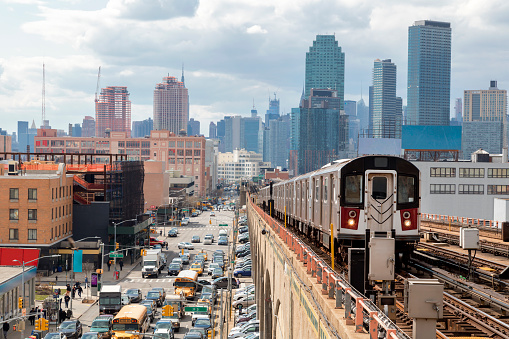News | UCLA Researchers Investigate Disparities in Transportation Access and Safety
Stop the VideoNews

UCLA Researchers Investigate Disparities in Transportation Access and Safety
Monday, February 7, 2022
Transportation in Los Angeles comes with a complicated and deeply controversial history. Although widely recognized as integral to accessing spaces of social and economic life, the planning, construction, operation, and maintenance of transportation infrastructure has been closely tied to displacement and gentrification, often running through, and functionally eliminating, communities of color. The Pacific Southwest Region University Transportation Center (PSR) funded a study entitled "Intersectional Transportation Trends in Los Angeles County” that examines travel patterns and traffic crash incidents across diverse populations. The study team was led by Madeline Brozen (UCLA Lewis Center for Regional Policy Studies), and included UCLA Department of Urban Planning students Nataly Rios, Isabel Cardenas, Annaleigh Yahata Ekman, and Ben Bressette (UCLA Department of Urban Planning). The study identified ways that racial disparities in transportation access and safety persist today, manifesting themselves in the unjust distribution of transportation resources.
The research team used two data sources, the National Household Travel Survey (2017) and 2013-2017 collision data from the California Statewide Integrated Traffic Records System. to analyze patterns in traffic crashes and travel behavior (I.e., daily travel distance, duration, trip count, and mileage). The researchers compared data for a variety of population groups based on identity. The groups examine included women and youth of color, Black people, people with disabilities, lower-income older adults, people living in families in poverty, and people living in priority population census tracts (as defined by CalEnviroScreen data).
The study identified two key research outcomes. First, disadvantaged populations (especially African Americans, women of color, people with mobility-restricting disabilities, and lower-income elderly adults) faced significant disparities, although, across population groups, trends varied. For instance, while women of color and African Americans traveled longer distances than average, low-income adults and families in poverty traveled the shortest distances. Similarly, internal differences existed within each group, especially by race and ethnicity. For example, trip durations for Black people with disabilities were double that of White people with disabilities. According to the researchers, much of this inequality emerged from the residual effects of redlining and segregation, which continue to shape transportation access in the status quo. These inequalities may potentially burden marginalized groups with ‘time poverty,’ or a lack of time to meet basic needs because of increased travel times. In addition to patterns highlighted in the data analysis, this report drew from previous literature and highlighted how harassment and police violence, particularly for Black people sculpt the relationship between race/ethnicity and transportation.
Second, the researchers found that those living in “priority population areas” as defined by California legislation/CalEnviroScreen) also faced disproportionate risks of traffic violence in the form of collisions. . Approximately 54% of pedestrian fatalities, 57% of bicyclist fatalities, and 44% of all collision fatalities occurred in these zones, which only comprise 11% of Los Angeles County’s total land area and ~43% percent of the population. Considering their share of the population, priority population areas statistically have more pedestrian and bicyclist fatalities than they should be relative to their population. Similarly, Black and Latino pedestrians specifically were overrepresented in fatalities.
As Los Angeles increasingly invests in transportation improvements focused on equity and sustainability to address a legacy of racism, this study contextualizes the need to address disparities in access and in traffic-related violence. To help guide L.A.’s future transit development, the researchers offer four recommendations:
1. Improve transportation infrastructure with a people-centric approach that prioritizes the disadvantaged, such as adding ramps to sidewalks, providing shade/sun protection for pedestrians, and increasing the frequency of transit service
2. Take actions such as limiting vehicle speeds and implementing automatic speed enforcement to prevent loss of life or severe injury
3. Find opportunities to increase transit travel speeds to not further burden disadvantaged travelers
4. Enhance data collection and develop new data gathering and assessment methods particularly for collisions.
These recommendations, as well as the need for a greater exploration of transportation inequity, present potential solutions to complex and deeply rooted transportation justice problems.
News Archive
- December (1)
- November (6)
- October (4)
- September (2)
- August (3)
- July (4)
- June (3)
- May (7)
- April (8)
- March (11)
- February (8)
- January (7)
- December (7)
- November (8)
- October (11)
- September (11)
- August (4)
- July (10)
- June (9)
- May (2)
- April (12)
- March (8)
- February (7)
- January (11)
- December (11)
- November (5)
- October (16)
- September (7)
- August (5)
- July (13)
- June (5)
- May (5)
- April (7)
- March (5)
- February (3)
- January (4)
- December (4)
- November (5)
- October (5)
- September (4)
- August (4)
- July (6)
- June (8)
- May (4)
- April (6)
- March (6)
- February (7)
- January (7)
- December (8)
- November (8)
- October (8)
- September (15)
- August (5)
- July (6)
- June (7)
- May (5)
- April (8)
- March (7)
- February (10)
- January (12)















